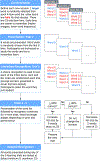Stricker Learning Span criterion validity: a remote self-administered multi-device compatible digital word list memory measure shows similar ability to differentiate amyloid and tau PET-defined biomarker groups as in-person Auditory Verbal Learning Test
- PMID: 37385974
- PMCID: PMC10756923
- DOI: 10.1017/S1355617723000322
Stricker Learning Span criterion validity: a remote self-administered multi-device compatible digital word list memory measure shows similar ability to differentiate amyloid and tau PET-defined biomarker groups as in-person Auditory Verbal Learning Test
Abstract
Objective: The Stricker Learning Span (SLS) is a computer-adaptive digital word list memory test specifically designed for remote assessment and self-administration on a web-based multi-device platform (Mayo Test Drive). We aimed to establish criterion validity of the SLS by comparing its ability to differentiate biomarker-defined groups to the person-administered Rey's Auditory Verbal Learning Test (AVLT).
Method: Participants (N = 353; mean age = 71, SD = 11; 93% cognitively unimpaired [CU]) completed the AVLT during an in-person visit, the SLS remotely (within 3 months) and had brain amyloid and tau PET scans available (within 3 years). Overlapping groups were formed for 1) those on the Alzheimer's disease (AD) continuum (amyloid PET positive, A+, n = 125) or not (A-, n = 228), and those with biological AD (amyloid and tau PET positive, A+T+, n = 55) vs no evidence of AD pathology (A-T-, n = 195). Analyses were repeated among CU participants only.
Results: The SLS and AVLT showed similar ability to differentiate biomarker-defined groups when comparing AUROCs (p's > .05). In logistic regression models, SLS contributed significantly to predicting biomarker group beyond age, education, and sex, including when limited to CU participants. Medium (A- vs A+) to large (A-T- vs A+T+) unadjusted effect sizes were observed for both SLS and AVLT. Learning and delay variables were similar in terms of ability to separate biomarker groups.
Conclusions: Remotely administered SLS performed similarly to in-person-administered AVLT in its ability to separate biomarker-defined groups, providing evidence of criterion validity. Results suggest the SLS may be sensitive to detecting subtle objective cognitive decline in preclinical AD.
Keywords: Alzheimer’s disease; aging; cognition; mobile health; neuropsychological tests; neuropsychology; smartphone; telemedicine.
Figures






References
-
- Alden EC, Lundt ES, Twohy EL, Christianson TJ, Kremers WK, Machulda MM, & Jack CR, Knopman DS, Mielke MM, Petersen RC, Stricker NH (2022). Mayo normative studies: A conditional normative model for longitudinal change on the Auditory Verbal Learning Test and preliminary validation in preclinical Alzheimer’s disease. Alzheimers Dement (Amst), 14(1), e12325. 10.1002/dad2.12325 - DOI - PMC - PubMed
-
- Alden EC, Pudumjee SB, Lundt ES, Albertson SM, Machulda MM, Kremers WK, Jack CR, Knopman DS, Petersen RC, Mielke MM, & Stricker NH (2021). Diagnostic accuracy of the Cogstate Brief Battery for prevalent MCI and prodromal AD (MCI A(+) T(+)) in a population-based sample. Alzheimers & Dementia, 17(4), 584–594, 10.1002/alz.12219, - DOI - PMC - PubMed
-
- American Psychiatric Association 1994, Diagnostic and Statistical Manual of Mental Disorders (DSM-IV), 4th edn). Washington, D.C: American Psychiatric Association.
-
- Ashford MT, Veitch DP, Neuhaus J, Nosheny RL, Tosun D, & Weiner MW (2021). The search for a convenient procedure to detect one of the earliest signs of Alzheimer’s disease: A systematic review of the prediction of brain amyloid status. Alzheimers & Dementia, 17(5), 866–887. 10.1002/alz.12253 - DOI - PubMed
-
- Atkinson RC, & Shiffrin RM (1968). Human memory: A proposed system and its control processes. In Spence KWSJT (Eds.), The psychology of learning and motivation: II. Cambridge, MA: Academic Press.
Publication types
MeSH terms
Substances
Grants and funding
LinkOut - more resources
Full Text Sources
Medical

